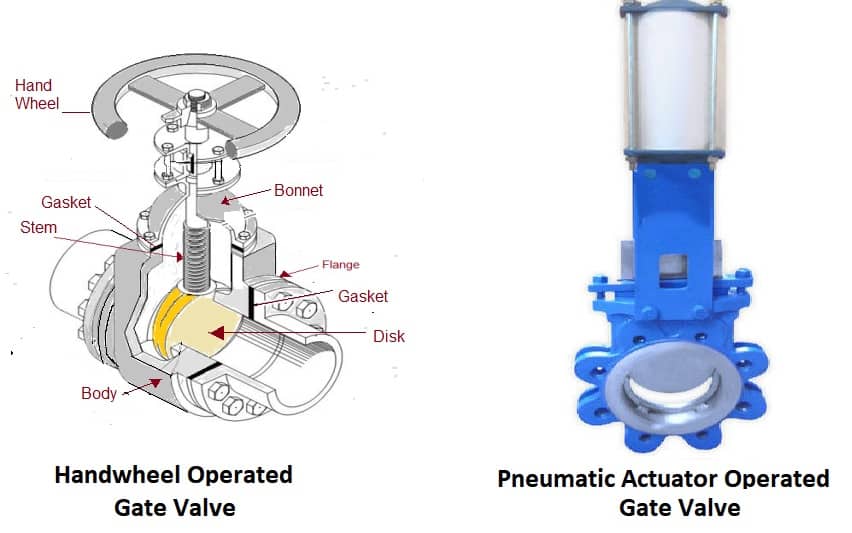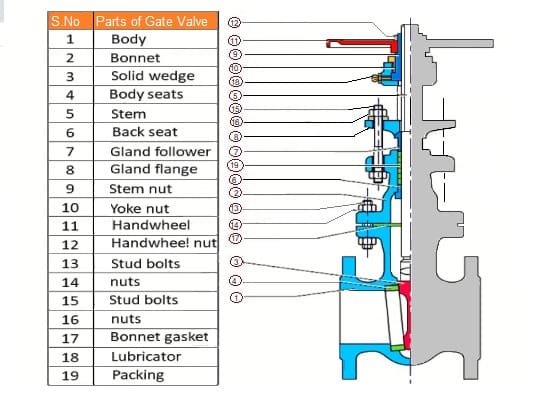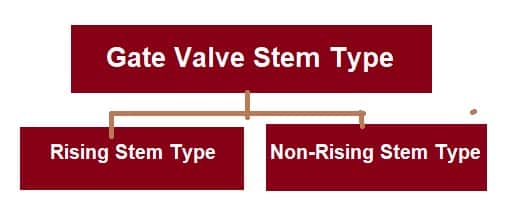Basics of gate Valves: Gate valve is a linear motion manual wheel, pneumatic, hydraulically actuated on/off service valve. The gate valve outnumbers other valve types in services where we require uninterrupted circulation and low-pressure drop.
The gate valve has multi-turn, in which the orifice is closed with a flat-faced vertical gate or disc. The disc or gate that slides at right angles over the seat.
Gate valves are not suitable for throttling services. These are suitable for on-off service. The reason is that the gate and seal tend to undergo rapid erosion while restricting circulation. Gate valves produce turbulence with the gate partially open, and also little noise.

The above figure shows the cut-view of a hand wheel operated gate valve, also a gate valve with a pneumatic actuator. When the valve is fully open, there is no restriction in the valve flow passage. Fluid passes in a straight line through the passage that has usually the same diameter as the pipe.
Various Parts of Gate Valve

Gate Valve Construction and Operation
The Gate valves control the flow of liquid by utilizing a flat disc. The flat disc has its position between the two parallel seating. Out of two seals, one seal is placed upstream and the other downstream. We use gate valves to effectively control the flow of water.
Gate Valves have a round handle for manual operation or a cylinder for pneumatic and hydraulic actuation used for high thrust service. The shaft rises when we turn the handle to open the valve. Though it is the most popular valve, it cannot be used where there is a space constraint. Two types of stem, one is rising stem and non-rising stem are available.

Rising Stem:
Rising stems fixes to the gate. As a result, the stems rise and lower with valve operation. It shows the visual indication of the valve movement which makes easy the greasing of the stem. Rising stem gate valves are most suitable for above-ground installations.
Non-Rising Stem
Non-rising stems are threaded inside the gate. The stem movement with the gate rising and gate lowering takes place inside the valve body. Require less vertical space because the stem is inside the valve body. Non-stem type gate valves are suitable for above as well as below ground installations.
Recommended for:
a. Service with total opening or total closing, without throttling.
b. Not recommended for continuous open/close operation. Gate valves are not suitable for frequent operations.
c. For minimum resistance to circulation.
d. Gate valves are highly recommended to drain for minimal amounts of fluid or liquid trapped in the pipeline.
Applications
General service, Crude oils, and petroleum, gas, air, semi-liquid pastes, thick liquids, steam, gases, and non-condensable liquids, corrosive liquids.
Advantages of Gate Valves
a) Gate valves are of high capacity.
b) Hermetic closure.
c) Low cost.
d) Simple design and operation.
e) Little resistance to circulation.
f) Gate valves can be installed in any direction.
Disadvantages of Gate Valve
a. Gate valves offer poor circulation control.
b. Gate valves require a lot of force to operate the gate.
c. Produces cavitation with low-pressure drop.
d. In operation, gate valves must be covered or closed completely.
e. The choke position will cause seat and disc erosion.
f. One major disadvantage is that the gate valves are not suitable for throttle service.
Variations
Four types of wedge are solid wedge, flexible wedge, split wedge, double-disc. The most popular one is the solid wedge disc. The solid wedge is a single moving part that will not jam. Split wedge and double disk valves have wedges that come in various parts.
Materials of Gate Valve
Body of construction of Gate valves includes Bronze, Cast Iron, Iron, Forged Steel, Monel, Cast Steel, Stainless Steel, and PVC Plastic.
Special instructions for installation and maintenance
a) Gate valves are required lubrication at regular intervals.
b) Correction of gasket leaks immediately.
c) Always need to cool the system when closing a pipe for hot liquids and checking that the valves are closed.
d) Gate valves operated to open slowly to avoid hydraulic shock in the pipeline.
e) Required to close valves slowly to help flush out trapped sediment and grime.
Specifications for ordering of Gate Valve
a) End connection type.
b) Wedge type.
c) Seat type.
d) Stem type.
e) Bonnet type.
f) Stem packing type.
g) Pressure rating for operation and design.
h) Temperature rating for operation and design.
Read Next :